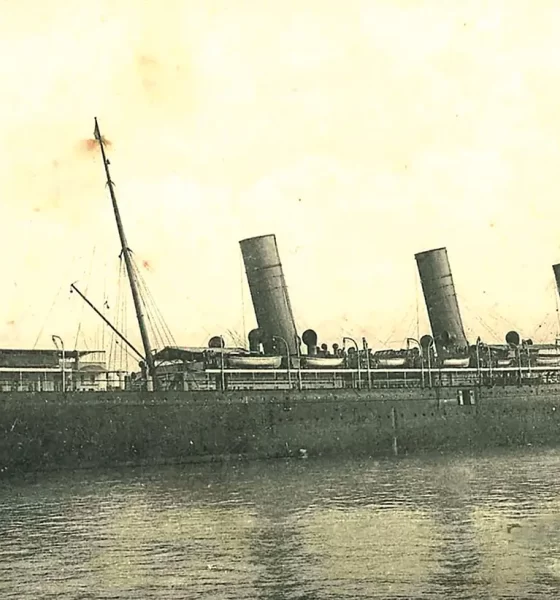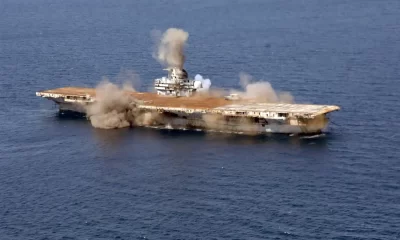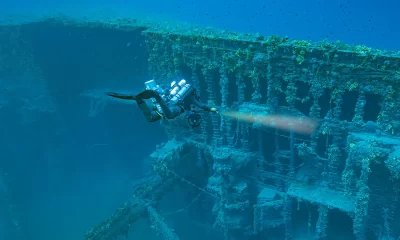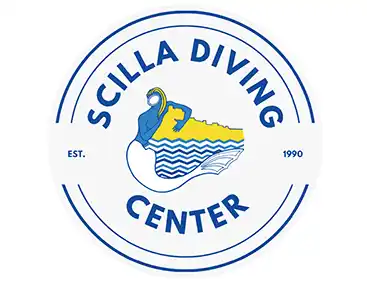

Exploration
SS Burdigala: An Elegant Mediterranean Wreck
Italian instructor, gear maker, and explorer Andrea Murdock Alpini shares the adventure of exploring the graceful wreck of the 19th century steam-powered cruiser, SS Burdigala, which sank in 1916 after hitting a German mine in the Kea Channel of Greece. The shipwreck lies at a depth of 76 m/249 ft.
by Andrea Murdock Alpini. Translation from Italian by Cristian Pellegrini. Historical photos courtesy of the D. Galon Archives. Wreck photos courtesy of Alexandre Legrix. Lead image: historic photo of the SS Burdigala.
It was 1898 and at Ferdinand Schichau’s shipyard the hull of the SS Kaiser Friedrich was laid down. The vessel was to be launched during the same year for Norddeutscher Lloyd in Bremen as a ship for transoceanic transport of up to 1,350 passengers. The Kaiser Friedrich was equipped with a steam propulsion system generated by quadruple-expansion engines giving power to two propellers.
The ship was 183 m/600 ft long by almost 20 m/66 ft wide, and had a gross tonnage of 12,480 tons; maximum cruising speed was 19 knots. In 1912 it changed both flag and name, passing to the French South Atlantic Navigation Company (Bordeaux) and officially becoming the SS Burdigala. It remained on ocean routes until it was requisitioned by the French Navy in Pauillac (Gironde) on 19 March 1915, when it entered in the military naval register as an auxiliary cruiser. The hull was upgraded and armed with two powerful cannons in the forward area. On 14 November 1916, the ship was sailing on a return mission from Thessaloniki to Toulon, when it sank due to a mine left by the German submarine U73 in the Kea channel, Greece.

Diving The Wreck
The dive started with a pretty strong surface current, which gets stronger and stronger as the descent takes us to the deck, at a depth of 58 m/190 ft.
Visibility is incredible here, at least 30 m/100 ft horizontally. The buoy is located inside the wide rift created by the impact with the mine. The twisted steel plates are of respectable thickness and size, and allow a glimpse of the interior.
I direct my diver propulsion vehicle (DPV) towards the starboard broadside across the rift. When I’m somewhat sheltered by the wreck, the comfort in the water is different; as soon as I’m exposed to the flow of the current, the conditions for exploration change radically. The starboard broadside flows pleasantly alongside us, and the dimensions are considerable. I’m totally captivated by the quantity of structures, details, and colours that make up the wreck.
When we reach the transom, we begin our descent towards the rudder and the propellers. The drift can be felt and pushes us away from the broadside that we are exploring. We gain a few metres as we pull back under the port broadside. The propeller blades now finally emerge before my eyes and then, looking upwards, the majesty of the stern appears in all its breadth.



I follow the propeller shaft from the bulb to the point where it connects to the hull. It is not a simple manifold: it’s a refined one, tapered into concentric, streamlined tubes. From these mouldings you can appreciate the quality of design in the SS Kaiser Friedrich liner.
Imposing lifeboat rafts adorn both sides. The deck below, increasingly corroded by marine agents over the years, is made up of wooden stumps that let you imagine what lies beneath the fins. I am attracted by the swirl of colours of sponges, within which a large spider crab, at least 60 cm in diameter, seems to be trapped. I first think it is probably asphyxiated, almost dead, but as I approach my hand it starts fighting back, shaking its claws. Instinctively I move closer to release it – at least one should be given its life back; after all the ones I ate at Place de l’Opéra in Paris, I think to myself, and so I do. I take my ventral knife and, with laborious care, I cut through the meshes of the net enveloping its body.
We reach the stanchion on the port side. The ascent feels never-ending, so high is the hull. It is actually about 15 m/50 ft, the propeller standing at 70 m/230 ft. We cross the deck transversally, multiple times, to gather as much information as possible about the wreck. The yellow, red and purple sponges that have colonised it make the dive even more exciting.
Every now and then I cast my gaze over the side. The visibility is so crystal clear that you can spot the silhouettes of some artefacts that have fallen from the ship onto the seabed, at 76 m/249 ft. We must not be tempted by these sibylline voices, so we continue towards the bow, which is still a long way off. The smokestacks have collapsed, only their points of connection with the central body of the hull remain. What must have once been a teak-covered deck now looks like a network of iron girders that give a glimpse of the spaces below. At the command bridge, which is spread over two levels, looking below the deck I see an elegant bathtub resting on lion feet. It must have been a furnishing accessory for the first-class cabins, later converted to accommodate the senior officers on board.

On to the Bow
I pursue my exploration pointing towards the bow. When I spot the cutwater, I feel at peace and rewarded for my efforts so far. A vertical line as sharp as a blade splits the view into two. These are moments that seem to last forever, the result of a state of catharsis in which I find myself before the beauty of these elements. I descended a few metres, attracted by the mighty anchor, at least a couple of metres high and just as wide, impressive. My eyes are dazzled by the details and the leap in size of the things that appear in sequence before me. I go up a little, towards the starboard side, move around the bridge a couple of times. I am literally surrounded by clouds of blue fish changing direction abruptly as I approach. They create shimmering silver reflections, gentle waves in a sea of current.
I reach the command bridge, a beautiful structure on two levels, elegant, large and full of instruments and details. As soon as I approach the command deck, a series of five turrets appear, along with machine telegraphs and electrical systems. Four of these turrets are still upright in their original position, a fifth is lying on the ground. Following it with my gaze, I notice among the blue, yellow, red, and purple sponges, a concretized lamp, the colour of which must have once been white, and that used to illuminate the foredeck below. A few metres farther on, I spot the respective lamp on the right, even more concretized. Both still have the glass in place.

Then, suddenly, it comes along: the largest gun I have ever seen arming a ship. 6 m/20 ft long, a diameter of at least 80 cm, a fire mouth of about 30 cm. Time dilates as I pass by and observe its details more closely. It cannot be compared to any of the armaments I have seen on similar battleships dived so far. It is simply immersive. On the other side of the hull, mirrored, lies its twin.
Stepping back a bit and ascending a few metres, I can see both guns, with the bridge in the background. At this point I think I’m lucky enough to admire something so marvellous and unique, and yet just a few metres further I also spot the flagpole used for sighting. It is intact, lying outboard, stretching from the deck to the sandy seabed. Halfway along its length appears the post, circular, where the lookout sailor stood.
A sudden thought crosses my mind, I’d love to observe it all! However, this would mean going back down, recompressing and, since the last few minutes of the planned dive are approaching, it doesn’t seem like a good idea, so in the end I give up. Heading back to the buoy, I am reminded of the initial descent towards the wreck, 45 minutes earlier, when a cloud of hundreds of amberjacks greeted me.
DIVE DEEPER
Other stories by the prolific Andrea Alpini Murdock:
InDEPTH: The Aftermath Of Love: Don Shirley and Dave Shaw
InDEPTH: Finessing the Grande Dame of the Abyss
InDEPTH: I See A Darkness: A Descent Into Germany’s Felicitas Mine
InDEPTH: Stefano Carletti: The Man Who Immortalized The Wreck of the Andrea Doria
InDEPTH: My Love Affair with the MV Viminale, the Italian Titanic
InDEPTH: Isverna Cave, Diving An Underground Dacia
InDEPTH: No Direction Home: A Slovenia Cave Diving Adventure

Andrea Murdock Alpini is a TDI and PSAI technical trimix and advanced wreck-overhead instructor based in Italy. He is fascinated by deep wrecks, historical research, decompression studies, caves, filming, and writing. He holds a Master’s degree in Architecture and an MBA in Economics for The Arts. Andrea is also the founder of PHY Diving Equipment. His life revolves around teaching open circuit scuba diving, conducting expeditions, developing gear, and writing essays about his philosophy of wreck and cave diving. He published his first book, Deep Blue: storie di relitti e luoghi insoliti (2018) and his next, IMMERSIONI SELVAGGE, was published in the fall of 2022. Recently he published a new wreck-historical book: ANDREA DORIA: UN LEMBO DI PATRIA (2023).























































